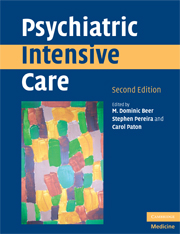Book contents
- Frontmatter
- Contents
- List of contributors
- Preface to second edition
- Preface to first edition
- Foreword
- Part I Therapeutic interventions
- Part II Interface issues
- Part III Management of the Psychiatric Intensive Care Unit/Low Secure Unit
- 21 Setting up a new Psychiatric Intensive Care Unit: principles and practice
- 22 Physical environment
- 23 Managing the Psychiatric Intensive Care Unit
- 24 Multidisciplinary teams within PICUs/LSUs
- 25 National Standards and good practice
- Index
- References
22 - Physical environment
from Part III - Management of the Psychiatric Intensive Care Unit/Low Secure Unit
Published online by Cambridge University Press: 22 August 2009
- Frontmatter
- Contents
- List of contributors
- Preface to second edition
- Preface to first edition
- Foreword
- Part I Therapeutic interventions
- Part II Interface issues
- Part III Management of the Psychiatric Intensive Care Unit/Low Secure Unit
- 21 Setting up a new Psychiatric Intensive Care Unit: principles and practice
- 22 Physical environment
- 23 Managing the Psychiatric Intensive Care Unit
- 24 Multidisciplinary teams within PICUs/LSUs
- 25 National Standards and good practice
- Index
- References
Summary
General philosophy of Psychiatric Intensive Care Low Secure Unit design
The introduction of the National Minimum Standards for General Adult Services in Psychiatric Intensive Care Units and Low Secure Environments (Department of Health 2002) has significantly improved the understanding of the nature of these two types of facilities. The standards were derived directly from the previous edition of this chapter (Dix 2001) and provide a checklist of specifications for physical design characteristics. Further advice may be found in the NICE Guidelines for the Short-Term Management of Disturbed (Violent) Behaviour in Psychiatric In-patient Settings (National Institute for Clinical Excellence 2005). While it is acknowledged that patient characteristics may vary between the two facilities, clinical experience suggests that the design features of both are concordant. Smith (1999) cites four competing needs as being involved in the design of a building: the needs of the commissioning trust, the needs of those managing the building, the needs of those caring for the patients and the needs of the patients themselves. This chapter aims to address those needs, in particular those of the patients and staff.
Much of the design, materials and specifications for the construction of psychiatric hospitals will be well known to NHS trusts' estates departments. Documents such as the design guide for medium secure units (NHS Estates 1993) and accommodation for people with mental illness (NHS Estates 1996) contain detailed guidance for hospital design, much of which is relevant to the PICU and Low Secure Unit (LSU).
- Type
- Chapter
- Information
- Psychiatric Intensive Care , pp. 294 - 305Publisher: Cambridge University PressPrint publication year: 2008
References
- 1
- Cited by

